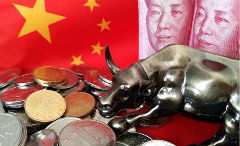Meeting growth target ‘no problem’
2017-10-11
China Daily
China not only will easily meet its economic growth target of around 6.5 percent this year, it may even beat it, Ning Jizhe, head of the National Bureau of Statistics, said on Oct 10 in Beijing.
“China will not have any problem at all meeting its growth target,” he said at a news conference while speaking about the country’s economic achievements since 2013. “The Chinese economy’s stabilizing and improving trend remains unchanged and the whole-year results could be even better (than the target).”
Ning commented ahead of the bureau’s release of third-quarter GDP data on Oct 19. Economists widely expect growth to remain stable, though it may soften a little in the third and fourth quarters.
Major international organizations such as the International Monetary Fund and the World Bank have shown more confidence in the world’s second-largest economy, raising their forecasts of its GDP growth this year.
In Washington on Oct 10, the IMF forecast China’s economy would grow by 6.8 percent in 2017-up by 0.2 percentage point from its April projection.
“The upward revision to the 2017 forecast reflects the stronger-than-expected outturn in the first half of the year, underpinned by previous policy easing and supply-side reform,” the report said.
Last week, the World Bank raised its growth forecast for China for this year to 6.7 percent from 6.5 percent in its June projection.
China’s economy grew by 6.9 percent in the first half of this year, up from last year’s 6.7 percent, which was the lowest rate in 26 years. If the whole-year growth turns out to be higher than 6.7 percent, it will mark the first acceleration in seven years.
Many indicators have shown that economic fundamentals also are improving, laying a solid foundation for future sustainable growth.
In the first eight months, China created 9.74 million urban jobs, driving the unemployment rate in 31 major cities down to 4.83 percent, the lowest since 2012, Ning said.
China has made much headway in its supply-side structural reform, he added. Economic restructuring has been boosted by the increasing role of sectors like services, online sales, the sharing economy and advanced manufacturing, which are new driving forces for growth, Ning said.
China’s contribution to global growth averaged about 30 percent annually from 2013 to 2016, larger than that of the United States, the eurozone and Japan combined, Ning added.


